Savannah, Georgia Blood Testing Facilities
 Represents a LabCorp blood testing facility
Represents a LabCorp blood testing facility Represents a Quest Diagnostics blood testing facility
Represents a Quest Diagnostics blood testing facility

Nearby Labcorp Blood Testing facilities:
- Labcorp Center Distance: 3 m, 107 Southern Blvd Ste 303, Savannah, Chatham County, GA, 31405
- Labcorp Center Distance: 4 m, 6349 Abercorn St Ste B, Savannah, Chatham County, GA, 31405
- Labcorp Center Distance: 18 m, 18 Oak Forest Road Ste B, Bluffton, Beaufort County, SC, 29910
- Labcorp Center Distance: 24 m, 8 Hospital Center Blvd Ste 140, Hilton Head Island, Beaufort County, SC, 29926
- Labcorp Center Distance: 31 m, 1865 N Paris Ave, Port Royal, Beaufort County, SC, 29935
- Labcorp Center Distance: 34 m, 462 Elma G Miles Pkwy, Hinesville, Liberty County, GA, 31313
- Labcorp Center Distance: 56 m, 215 Mims Rd, Sylvania, Screven County, GA, 30467
- Labcorp Center Distance: 63 m, 501 Robertson Blvd, Walterboro, Colleton County, SC, 29488
- Labcorp Center Distance: 64 m, Highway 278, Fairfax, Other, SC, 29827
- Labcorp Center Distance: 66 m, 2311 Parkwood Drive, Brunswick, Glynn County, GA, 31520
- Labcorp Center Distance: 80 m, 1843 Ashley River Rd, Charleston, Charleston County, SC, 29407
- Labcorp Center Distance: 81 m, 105A Harth Pl, Summerville, Dorchester County, SC, 29485
- Labcorp Center Distance: 82 m, 3825 Faber Place Dr, North Charleston, Charleston County, SC, 29405
- Labcorp Center Distance: 85 m, 2850 Tricom Street, North Charleston, Charleston County, SC, 29406
- Labcorp Center Distance: 88 m, 1280 Hospital Drive Unit 1, Mount Pleasant, Charleston County, SC, 29464
- Labcorp Center Distance: 89 m, 163 South Tallahassee Street, Hazlehurst, Jeff Davis County, GA, 31539
- Labcorp Center Distance: 94 m, 60 Andrews Way, Saint Marys, Camden County, GA, 31558
Nearby Quest Blood Testing facilities:
- Quest Center Distance: 4 m, 6606 Abercorn St, Savannah, Chatham County, GA, 31405-5817
- Quest Center Distance: 24 m, 460 William Hilton Pkwy, Hilton Head Island, Beaufort County, SC, 29926-2497
- Quest Center Distance: 45 m, 1601 Fair Rd, Statesboro, Bulloch County, GA, 30458-0801
- Quest Center Distance: 65 m, 3389 Cypress Mill Rd, Brunswick, Glynn County, GA, 31520-2860
- Quest Center Distance: 76 m, 512 Maple Dr, Vidalia, Toombs County, GA, 30474-8912
- Quest Center Distance: 79 m, 1470 Tobias Gadson Blvd, Charleston, Charleston County, SC, 29407-4707
- Quest Center Distance: 80 m, 418 Folly Road, Charleston, Charleston County, SC, 29412-2625
- Quest Center Distance: 81 m, 1203 Old Trolley Rd, Summerville, Dorchester County, SC, 29485-5296
- Quest Center Distance: 94 m, 2103 Tebeau St, Waycross, Ware County, GA, 31501-6981
Savannah Georgia Hormone Replacement Therapy Services
Hormone Optimization is a modern breakthrough in medical science which has opened new doors for health and wellness treatment, with the aim of helping patients live longer lives with heightened vitality. The Conscious Evolution Institute is at the forefront of Hormone Science. Our Hormone Doctors have significant experience in a variety of the cutting-edge, 21st century hormone treatments available today, including HGH Injection Therapy and Testosterone Restoration for Low-T.
If you've ever been curious regarding your hormone balance and how it relates to your overall physiological health, we encourage you to contact us, especially if you feel as though changes in your metabolism and overall health have been suppressing your wellness. The Conscious Evolution Institute treats men and women thirty years of age and older.
Call us directly or fill out the form on this page, and we can arrange an appointment for you with one of our affiliate medical specialists operating in the Savannah Georgia area. If your physical exam and bloodwork show that you can benefit from Testosterone, HGH, or any other Hormone Replacement option, we can write you a prescription and design a wellness regimen designed to maximize the results of your quality HRT Therapy.
Savannah Georgia HGH Clinics for Human Growth Hormone Therapy
One of the hottest topics in Hormone Therapy today is Bio-Identical Human Growth Hormone. For decades, researchers have been unearthing the secrets of HGH and how it impacts our health. It turns out that Human Growth Hormone is intrinsically important to practically every system in the human body with regard to optimal function. This is because HGH is an agent of cellular metabolism. Its goal as a hormone is to help your body run more smoothly, and to more effectively meet its own needs.
Age-Related HGH Deficiency (also known as Somatopause) wreaks havoc on the ability of the body to maintain itself, because diminished Human Growth Hormone Levels prevent the body from maintaining a healthy baseline of function. Symptoms of Growth Hormone Deficiency include increased bodyfat, loss of muscle mass, depression, mild cognitive impairment, loss of focus, poor cholesterol levels, increased risk of diabetes and osteoporosis, and more. Having your HGH Levels checked is easy, and HGH Injections are easier to self-administer than ever, especially with special tools provided with name-brand HGH Products such as Humatrope and Nutropin. Most patients experience significant improvements in health and wellness after only six months of treatment.
Savannah Georgia Sermorelin Acetate Alternative to HGH Injections
Unfortunately, there are some restrictions associated with Human Growth Hormone Therapy that can limit its use, even for those that can benefit from the treatment. Because of the illicit use of HGH for the purpose of performance enhancement, there are strict guidelines for who can and cannot be prescribed real HGH, and Hormone Clinics are not allowed to prescribe Human Growth Hormone off-label. This means that there are many people that can see a real improvement in wellness from Recombinant Human Growth Hormone that are left out in the cold.
Luckily, there is another treatment known as Sermorelin Acetate Therapy that has been proven to be just as effective as real Human Growth Hormone for patients suffering from Somatopause. Sermorelin works by stimulating the natural secretion of HGH by the pituitary. It's less expensive than Growth Hormone while providing a similar range of results. Ask one of our Hormone Specialists to learn more!
Savannah Georgia Low-T and Testosterone Replacement Centers
Since the turn of the century, interest in Testosterone Therapy has skyrocketed, and for good reason. Study after study has shown that, for patients diagnosed with Low-T, Testosterone Creams, Injections, and Patches can lead to drastic improvements in sexual health and physiological function. Most people think of Bio-Identical Testosterone strictly as a treatment for sexual dysfunction and low libido, but this could be no further from the truth.
Testosterone Deficiency, in addition to causing inhibited sex drive and sexual performance, also causes or contributes to other vitality-suppressing issues such as fatigue, anxiety, high blood pressure, poor cholesterol levels, loss of strength, weight gain, and a host of other issues. By boosting Testosterone Levels, it is possible to mitigate these symptoms of Age-Related Testosterone Deficiency (or Andropause), through regular treatments of Testosterone applied to the skin topically or injected intramuscularly. In the past few years, studies have continued to boost the safety profile of Testosterone, and, when used under the guidance of a licensed Hormone Doctor, it can improve vitality and sexual health with minimal risk.
Savannah Georgia Information
Savannah is an important port city off of the coast of Georgia. It is located just across the Savannah River from the state of South Carolina. Because of its strategically important location, Savannah is the oldest established city in the state of Georgia, as it was founded in 1733. The cornerstone of the Savannah economy is shipping. Savannah is actually the 4th busiest port in all of North America with regard to incoming and outgoing shipping containers. Major companies that operate out of Savannah are Morris Multimedia, TitleMax, and Gulfstream Aerospace.
Because Savannah is such an old city, it is rich in both history and culture. Many love to visit the city just to see the cobblestone streets and historic buildings such as the first Bryan Baptist Church and the Independent Presbyterian Church. Fort Jackson is a popular attraction for people interested in military history, as it was an important entrenchment in both the War of 1812 and the Civil War. Other attractions include the Tybee Island Light Station, the Telfair Museum of Art, and Forsyth Park.
Savannah is well known for its beautiful scenery, as there are numerous islands and beaches lining the coast north and south of the city, including Cockspur Island, Wilmington Island, the Isle of Hope, and the famous Tybee Island. Suburbs of Savannah include Garden City, Port Fentworth, Pooler, Bloomingdale, Richmond Hill, and Vernonburg. Among the neighborhoods of Savannah are Ardsley Park, Habersham Woods, Skidaway Island, the Victorian District, and the Savannah Historic Downtown District. The Savannah area is also well-known for its conservation efforts, the largest of which are the Savannah National Wildlife Refuge and the Wassaw National Wildlife Refuge.
All About Savannah, Georgia Geographic Area

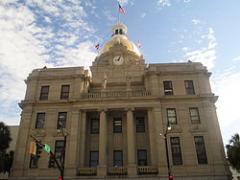
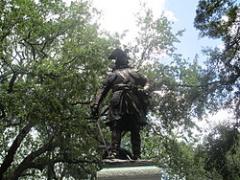
Savannah is the largest city and the county seat of Chatham County, in the U.S. state of Georgia. Established in 1733, the city of Savannah was the colonial capital of the Province of Georgia and later the first state capital of Georgia. Today Savannah is an industrial center and an important Atlantic seaport. It is Georgia's fifth largest city and third largest metropolitan area.
Each year Savannah attracts millions of visitors, who enjoy the city's architecture and historic buildings: the birthplace of Juliette Gordon Low (founder of the Girl Scouts of the United States of America), the Georgia Historical Society (the oldest continually operating historical society in the South), the Telfair Academy of Arts and Sciences (one of the South's first public museums), the First African Baptist Church (one of the oldest African American Baptist congregations in the United States), Temple Mickve Israel (the third oldest synagogue in America), and the Central of Georgia Railway roundhouse complex (the oldest standing antebellum rail facility in America).
Savannah's downtown area, which includes the Savannah Historic District, the Savannah Victorian Historic District and 22 parklike squares, is one of the largest National Historic Landmark Districts in the United States (designated by the U.S. government in 1966).[A] Downtown Savannah largely retains the original town plan prescribed by founder James Oglethorpe (a design now known as The Oglethorpe Plan). Savannah was the host city for the sailing competitions during the 1996 Summer Olympics held in Atlanta.
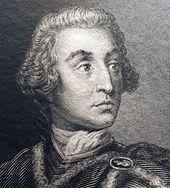
On February 12, 1733, General James Oglethorpe and his settlers landed at Yamacraw Bluff and were greeted by Tomochichi, the Yamacraws, and Indian traders John and Mary Musgrove. Mary Musgrove often served as a translator. The city of Savannah was founded on that date, along with the colony of Georgia. In 1751 Savannah and the rest of Georgia became a Royal Colony and Savannah was made the colonial capital of Georgia.
The city was named for the Savannah River, which probably derives from variant names for the Shawnee, a Native American people who migrated to the river in the 1680s. The Shawnee destroyed another Native people, the Westo, and occupied their lands at the head of the Savannah River's navigation on the fall line, near present-day Augusta. These Shawnee were known by several local variants, including Shawano, Savano, Savana and Savannah. Another theory is that the name Savannah refers to the extensive marshlands surrounding the river for miles inland, and is derived from the English term savanna, a kind of tropical grassland, which was borrowed by the English from Spanish sabana and used in the Southern Colonies. (The Spanish word comes from the Taino word zabana.) Still other theories suggest that the name Savannah originates from Algonquian terms meaning "southerner" or perhaps "salt".
According to the United States Census Bureau, Savannah has a total area of 78.1 square miles (202.3 km2), of which 74.7 square miles (193.5 km2) is land and 3.4 square miles (8.8 km2) is water (4.31%). Savannah is the primary port on the Savannah River and the largest port in the state of Georgia. It is also located near the U.S. Intracoastal Waterway. Georgia's Ogeechee River flows toward the Atlantic Ocean some 16 miles (26 km) south of the city.
Savannah is prone to flooding. Five canals and several pumping stations have been built to help reduce the effects: Fell Street Canal, Pipemaker's Canal, Kayton Canal, Springfield Canal and the Casey Canal, with the first four draining north into the Savannah River.
Savannah's climate is classified as humid subtropical (Koppen Cfa). In the Deep South this climate is characterized by long and almost tropical summers, with temperatures reaching freezing only a few times in the winter (and with rare snowfall). Due to its proximity to the Atlantic coast, Savannah rarely experiences temperatures as extreme as those in Georgia's interior. Nevertheless, temperatures as high as 105 °F (41 °C) and as low as 3 °F ( na16 °C) have been recorded. Summers tend to be humid with many thunderstorms. Nearly half of Savannah's precipitation falls during the months of June through September, characteristic of monsoon-type climates. As the city is south of the snow line, it rarely receives snow in winter. Occasional Arctic cold fronts in winter can push nighttime temperatures into the high 20s, but rarely much further than that.
Savannah is at risk for hurricanes, particularly of the Cape Verde type. Because of its location in the Georgia Bight (the arc of the Atlantic coastline in Georgia and northern Florida) as well as the tendency for hurricanes to re-curve up the coast, Savannah has a lower risk of hurricanes than some other coastal cities such as Charleston, South Carolina. Savannah was seldom affected by hurricanes during the 20th century, with one exception being Hurricane David in 1979. However, the historical record shows that the city was frequently affected during the second half of the 19th century. The most prominent of these storms was the 1893 Sea Islands hurricane, which killed at least 2,000 people. (This estimate may be low, as deaths among the many impoverished rural African-Americans living on Georgia's barrier islands may not have been reported.)
The first meteorological observations in Savannah probably occurred at Oglethorpe Barracks circa 1827. Observations at the barracks continued intermittently until 1850 and resumed in 1866. The Signal Service began observations in the early 1870s. Today, the National Weather Service records local weather observations at Savannah-Hilton Head International Airport.
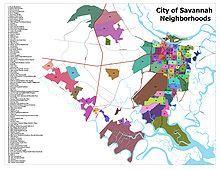
Savannah is a city of diverse neighborhoods. More than 100 distinct neighborhoods can be identified in six principal areas of the city: Downtown (Landmark Historic District and Victorian District), Midtown, Southside, Eastside, Westside, and Southwest/West Chatham (recently annexed suburban neighborhoods).
Besides the Savannah Historic District, one of the nation's largest, four other historic districts have been formally demarcated:
According to the U.S. Census Bureau, Savannah's 2011 estimated population was 139,491, slightly up from the official 2010 count of 136,286 residents. The Census Bureau estimated the 2011 population of the Savannah Metropolitan Statistical Area (defined by the Census Bureau as Bryan, Chatham, and Effingham counties) to be 355,576. Between 2000 and 2010, Savannah's metro area grew from 293,000 to 347,611, an increase of 18.6 percent. Savannah is also the largest principal city of the Savannah-Hinesville-Fort Stewart Combined Statistical Area, a larger trading area that includes the Savannah and Hinesville-Fort Stewart metropolitan areas. The 2011 estimated combined population was 436,163. Between 2000 and 2010, the combined population grew from 364,914 to 425,528, an increase of 16.6 percent.
In the 2010 census, there were 136,286 people, 52,615 households, and 31,390 families residing in the city. The population density was 1,759.5 people per square mile (679.4/km ²). There were 57,437 housing units at an average density of 768.5 per square mile (296.7/km ²). The racial makeup of the city was 55.04% Black, 38.03% White, 2.00% Asian, 0.03% Native American, 0.01% Pacific Islander, 0.93% from other races, and 2.01% from two or more races. Hispanic or Latino of any race were 4.07% of the population. Non-Hispanic Whites were 32.6% of the population in 2010, compared to 46.2% in 1990.
There were 51,375 households out of which 28.5% had children under the age of 18 living with them, 35.2% were married couples living together, 21.7% had a female householder with no husband present, and 38.9% were non-families. 31.4% of all households were made up of individuals and 11.5% had someone living alone who was 65 years of age or older. The average household size was 2.45 and the average family size was 3.13.
In the city the population was spread out with 25.6% under the age of 18, 13.2% from 18 to 24, 28.5% from 25 to 44, 19.5% from 45 to 64, and 13.3% who were 65 years of age or older. The median age was 32 years. For every 100 females there were 89.3 males. For every 100 females age 18 and over, there were 84.6 males.
The median income for a household in the city was $29,038, and the median income for a family was $36,410. Males had a median income of $28,545 versus $22,309 for females. The per capita income for the city was $16,921. About 17.7% of families and 21.8% of the population were below the poverty line, including 31.4% of those under age 18 and 15.1% of those age 65 or over.
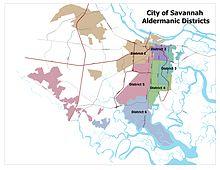
Savannah's government became a council/manager form of government in 1954. The city council consists of the mayor and eight aldermen, six of which are elected from one of six aldermanic districts, with each district electing one member. The other two members and the mayor are elected at-large.
The council levies taxes, enacts ordinances, adopts the annual budget, and appoints the City Manager. The City Manager enacts the policies and programs established by council, recommends an annual budget and work programs, appoints bureau and department heads, and exercises general supervision and control over all employees of the city.
In 2003 Savannah and Chatham County voted to merge their city and county police departments. The Savannah-Chatham Metro Police was established on January 1, 2005, after the Savannah Police Department and Chatham County Police Department merged. The department has a number of specialty units, including: K-9, SWAT, Bomb Squad, Marine Patrol, Dive, Air Support and Mounted Patrol. The 9-1-1 Communications Dispatch Center handles all 9-1-1 calls for service within the county and city, including fire and EMS.
While some see the police merger as a step toward city-county consolidation, Savannah is actually one of eight incorporated cities or towns in Chatham County. (The others are Bloomingdale, Garden City, Pooler, Port Wentworth, Thunderbolt, Tybee Island and Vernonburg). Although these seven smaller localities would remain independent from a consolidated government, they have long opposed any efforts to adopt a city-county merger. One fear is that consolidation would reduce county funding to areas outside of Savannah. Efforts toward city-county consolidation are also opposed by some wealthier Chatham County communities, including The Landings on Skidaway Island, since these residents fear higher tax rates in a consolidated government. However, consolidation is favored by some city and county boosters, including Savannah's main newspaper, and merger plans have been presented to state legislators in the recent past. Should consolidation pass, Savannah would become Georgia's second largest city (behind Atlanta's 420,000 residents), with a population of around 223,000. By state law, the roughly 42,000 residents of the seven smaller incorporated towns would remain independent; they are not included in a Savannah-Chatham consolidation plan. Without special provisions, however, some of these towns would find themselves permanently locked into their current city limits without possibility of further annexation.
The Georgia Department of Corrections operates the Coastal State Prison in Savannah.
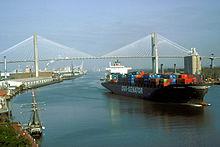
Agriculture was essential to Savannah's economy during its first two centuries. Silk and indigo production, both in demand in England, were early export commodities; by 1767 almost a ton of silk per year was exported to England.
Georgia's mild climate offered perfect conditions for growing cotton, which became the dominant commodity after the American Revolution. Its production under the plantation system and shipment through the Port of Savannah helped the city's European immigrants to achieve wealth and prosperity.
In the nineteenth century, the Port of Savannah became one of the most active in the United States, and Savannahians had the opportunity to consume some of the world's finest goods, imported by foreign merchants. Savannah's port has always been a mainstay of the city's economy. In the early years of the United States, goods produced in the New World had to pass through Atlantic ports such as Savannah's before they could be shipped to England.
Today, the Port of Savannah, manufacturing, the military and the tourism industry are Savannah's four major economic drivers. In 2006, the Savannah Area Convention & Visitors Bureau reported over 6.85 million visitors to the city during the year. By 2011, the Bureau reported that the number of visitors the city attracted increased to 12.1 million. Lodging, dining, entertainment, and visitor-related transportation account for over $2 billion in visitors' spending per year and employ over 17,000.
For years, Savannah was the home of Union Camp, which housed the world's largest paper mill. The plant is now owned by International Paper, and it remains one of Savannah's largest employers. Savannah is also home to the Gulfstream Aerospace company, maker of private jets, as well as various other large industrial interests. TitleMax, a privately owned title lending company with over 600 stores across 12 states, is headquartered in Savannah. Morris Multimedia, a newspaper and television company, is also based in Savannah.
In 2000, JCB, the third largest producer of construction equipment in the world and the leading manufacturer of backhoes and telescopic handlers, built its North American headquarters in Chatham County near Savannah in Pooler on I-95 near Savannah-Hilton Head International Airport.
In 2009, Savannah was North America's fourth largest port by container traffic.
Beyond its architectural significance as being the nation's largest, historically restored urban area, the city of Savannah has a rich and growing performing arts scene, offering cultural events throughout the year.
Savannah Dance Theatre ae established in 1998 as a nonprofit organization, the theatre has grown to become the city aos largest dance company.
Several heavy metal music groups have emerged from Savannah. Included in these are Baroness, Kylesa and Circle Takes the Square.
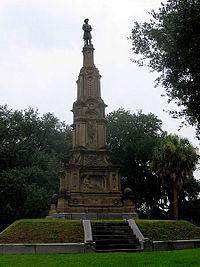
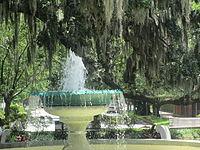
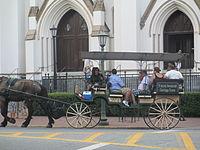
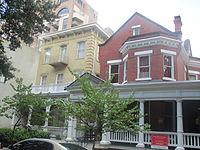
Savannah's architecture, history, and reputation for Southern charm and hospitality are internationally known. The city's former promotional name was "Hostess City of the South," a phrase still used by the city government. An earlier nickname was "the Forest City", in reference to the large population and species of oak trees that flourish in the Savannah area. These trees were especially valuable in shipbuilding during the 19th century. Each year, Savannah attracts millions of visitors from across the country and around the world. Savannah's downtown area is one of the largest National Historic Landmark Districts in the United States.
The city's location offers visitors access to the coastal islands and the Savannah Riverfront, both popular tourist destinations. Tybee Island, formerly known as "Savannah Beach", is the site of the Tybee Island Light Station, the first lighthouse on the southern Atlantic coast. Other picturesque towns adjacent to Savannah include the shrimping village of Thunderbolt and three residential areas that began as summer resort communities for Savannahians: Beaulieu, Vernonburg, and the Isle of Hope.
The Savannah International Trade & Convention Center is located on Hutchinson Island, across from downtown Savannah and surrounded by the Savannah River. The Belles Ferry connects the island with the mainland, as does the Eugene Talmadge Memorial Bridge.
The Savannah Civic Center on Montgomery Street is host to more than nine hundred events each year.
Savannah has consistently been named one of "America's Favorite Cities" by Travel and Leisure Magazine. In 2012, Travel and Leisure Magazine rated Savannah highest in "Quality of Life and Visitor Experience." Savannah was also ranked first for "Public Parks and Outdoor Access," visiting in the Fall, and as a romantic escape. Savannah was also named as America's second-best city for "Cool Buildings and Architecture," behind only Chicago.
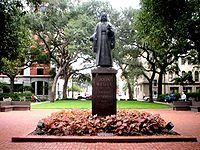
Savannah's historic district has 22 squares (Ellis Square, demolished in 1954, was fully restored in early 2010). The squares vary in size and personality, from the formal fountain and monuments of the largest, Johnson, to the playgrounds of the smallest, Crawford. Elbert, Ellis, and Liberty Squares are classified as the three "lost squares," destroyed in the course of urban development during the 1950s. Elbert and Liberty Squares were paved over to make way for a realignment of U.S. highway 17, while Ellis Square was demolished to build the City Market parking garage. The city restored Ellis Square after razing the City Market parking garage. The garage has been rebuilt as an underground facility, the Whitaker Street Parking Garage, and it opened in January 2009. The newly restored Ellis Square opened in March 2010. Separate efforts are now under way to revive Elbert and Liberty Squares.
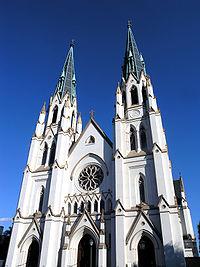
Savannah is home to a number of historic houses of worship.
Founded in 1733, with the establishment of the Georgia colony, Christ Church is the longest continuous Christian congregation in Georgia. Early rectors include the Methodist evangelists John Wesley and George Whitefield. Located on the original site on Johnson Square, Christ Church continues as an active congregation.
The First Bryan Baptist Church is an African-American church that was organized by Andrew Bryan in 1788. The site was purchased in 1793 by Bryan, a former slave who had also purchased his freedom. The first structure was erected there in 1794. By 1800 the congregation was large enough to split: those at Bryan Street took the name of First African Baptist Church, and Second and Third African Baptist churches were also established. The current sanctuary of First Bryan Baptist Church was constructed in 1873.
In 1832, a controversy over doctrine caused the First African Baptist congregation at Bryan Street to split. Some members left, taking with them the name of First African Baptist Church. In 1859, the members of this new congregation (most of whom were slaves) built their current church building on Franklin Square.
The oldest standing house of worship is First Baptist Church, Savannah (1833), located on Chippewa Square. Also located near Chippewa Square is the Independent Presbyterian Church, which was founded in 1775.
Other historic houses of worship in Savannah include: Cathedral of St. John the Baptist (Roman Catholic), Temple Mickve Israel (the third oldest synagogue in the U.S.), and St. John's Church (Episcopal).
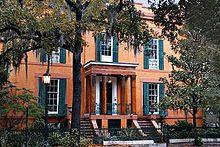
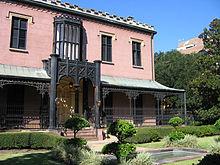
Among the historic homes that have been preserved are: the Pink House, the Sorrel Weed House, Juliette Gordon Low's birthplace, the Green-Meldrim House, the Owens-Thomas House, the William Scarbrough House, and the Wormsloe plantation of Noble Jones. The Mercer-Williams House, the former home of Jim Williams, is the main location of Midnight in the Garden of Good and Evil
Colonial Park Cemetery (an early graveyard dating back to the English colony of Georgia), Laurel Grove Cemetery (with the graves of many Confederate soldiers and African American slaves) and Bonaventure Cemetery (a former plantation and the final resting place for some illustrious Savannahians).
Fort Jackson, not associated with Andrew Jackson, one mile east of Savannah's Historic District, was originally built between 1808 and 1812 to protect the city from attack by sea; during the Civil War it became one of three Confederate forts defending Savannah from Union forces. Fort Pulaski National Monument, located 17 miles (27 km) east of Savannah, preserves the largest fort protecting Savannah during the Civil War; the Union Army attacked Fort Pulaski in 1862 with the aid of a new rifled cannon that effectively rendered brick fortifications obsolete.
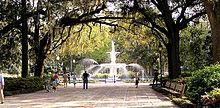
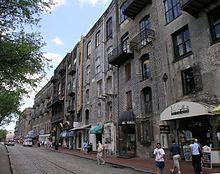
Various centers for shopping exist about the city including Abercorn Common, Savannah Historic District, Oglethorpe Mall, Savannah Mall and Abercorn Walk.
Auto Racing
Baseball
Basketball
Hockey
Football
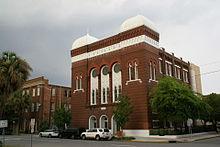
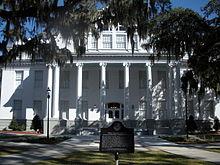
Savannah has four colleges and universities offering bachelor's, master's, and professional or doctorate degree programs: Armstrong Atlantic State University, Savannah College of Art and Design (SCAD), Savannah State University, and South University. In addition, Georgia Tech Savannah offers engineering degrees, and Georgia Southern University has a satellite campus in the downtown area. Savannah Technical College, a two-year technical institution, and the Skidaway Institute of Oceanography, a marine science research institute located on the northern end of Skidaway Island, offer educational programs as well. Savannah is also the location of Ralston College, a liberal arts college founded in 2010.
Mercer University began a four-year doctor of medicine program in August 2008 at Memorial University Medical Center. Mercer, with its main campus in Macon, received additional state funding in 2007 to expand its existing partnership with Memorial by establishing a four-year medical school in Savannah (the first in southern Georgia). Third- and fourth-year Mercer students have completed two-year clinical rotations at Memorial since 1996; approximately 100 residents are trained each year in a number of specialities. The expanded program opened in August 2008 with 30 first-year students.
Savannah is also home to most of the public schools in the Chatham County public school system, the Savannah-Chatham County Public Schools.
Other notable schools include:
Oatland Island Wildlife Center of Savannah is also a part of Savannah-Chatham County Public Schools. Formerly named the Oatland Island Education Center until a name change in 2007, the environmental education center serves thousands of students from school systems throughout the Southeastern United States. It is located just east of Savannah on a marsh island and features a 2-mile (3.2 km) Native Animal Nature Trail that winds through maritime forest, salt marsh, and freshwater wetlands. Along the trail, visitors can observe native animals, such as Florida panthers, Eastern timber wolves, and alligators, in their natural habitat.
Savannah's major television stations are WSAV, channel 3 (NBC); WTOC-TV, channel 11 (CBS); WJCL, channel 22 (ABC); and WTGS, channel 28 (Fox). Two PBS member stations serve the city: WVAN (channel 9), part of Georgia Public Broadcasting; and WJWJ-TV (channel 16), part of SCETV.
Other stations include WGSA-TV, channel 34 (The CW); and WXSX-CA, channel 46 (MTV2).
The Savannah Morning News is Savannah's only daily newspaper. The Savannah Tribune and the Savannah Herald are weekly newspaper with a focus on Savannah's African American community. Connect Savannah is an alternative free weekly newspaper focused on local news, culture and music.
Savannah/Hilton Head International Airport is located off Interstate 95 west of Savannah. Airlines serving this airport are Delta, Delta Connection, United Express, US Airways, Vision Airlines and American Eagle. Until September 2008, DayJet provided on-demand air transportation service between Savannah and cities throughout the Southeast.
Amtrak operates a passenger terminal at Savannah for the Palmetto and Silver Service trains running between New York City and Miami, Florida with three southbound and three northbound trains stopping at the station daily.
Public transit throughout the region is provided by Chatham Area Transit.
The DOT (Downtown Transportation) system provides fare free transportation in the Historic District. Services include an express shuttle buses, the River Street Streetcar, and a ferry to Hutchinson Island and the Savannah International Trade and Convention Center.
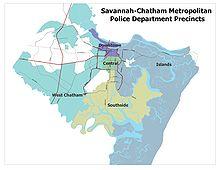
The total number of violent crimes in the Savannah-Chatham County reporting area ran just above 1,000 per year from 2003 through 2006. In 2007, however, the total number of violent crimes jumped to 1,163. Savannah-Chatham has recorded between 20 and 25 homicides each year since 2005.
In 2007, Savannah-Chatham recorded a sharp increase in home burglaries but a sharp decrease in larcenies from parked automobiles. During the same year, statistics show a 29 percent increase in arrests for Part 1 crimes.
An additional increase in burglaries occurred in 2008 with 2,429 residential burglaries reported to Savannah-Chatham police that year. That reflects an increase of 668 incidents from 2007. In 2007, there were 1,761 burglaries, according to metro police data.
Savannah-Chatham police report that crimes reported in 2009 came in down 6 percent from 2008.
In 2009, 11,782 crimes were reported to metro police ae 753 fewer than in 2008. Within that 2009 number is a 12.2 percent decrease in violent crimes when compared with 2008. Property crimes saw a 5.3 percent decline, which included a 5.2 percent reduction in residential burglary. In 2008, residential burglary was up by almost 40 percent.While some violent crimes increased in 2009, crimes like street robbery went down significantly.In 2009, 30 homicides were reported, four more than the year before. Also, 46 rapes were reported, nine more than the year before. In the meantime, street robbery decreased by 23 percent. In 2008, metro police achieved a 90 percent clearance rate for homicide cases, which was described as exceptional by violent crimes unit supervisors. In 2009, the department had a clearance rate of 53 percent, which police attributed to outstanding warrants and grand jury presentations.
The SCMPD provide the public with up to date crime report information through an online mapping service. This information can be found at
Savannah has four sister cities, as designated by Sister Cities International:
Word Count: 4823





